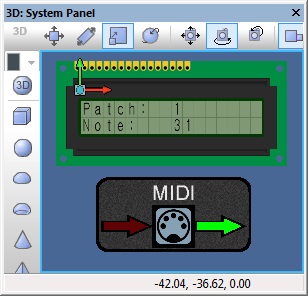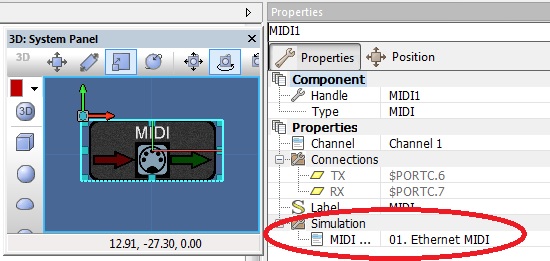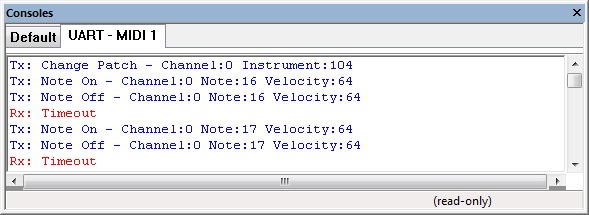Component: MIDI (Comms: System)
| Author | Matrix Ltd. |
| Version | 2.0 (Release) |
| Category | Comms: System |
Contents
 MIDI component
MIDI component
Low level routines for controlling or interacting with a standard MIDI interface.
Examples
Basic example to play a series of notes getting higher in pitch and then going down in pitch. This repeats in a loop and each time the loop repeats the instrument is changed. The current note and instrument are displayed on the LCD.
![]() MIDI Test File
MIDI Test File

The MIDI component during simulation has functionality to allow it to work with MIDI synthesizers installed on your PC.
To select your software or hardware synthesizer select from the property selector.
If you don't have a MIDI interface installed then IP MIDI seems to be a good option that works well.
Once installed the MIDI output should play through your computer speakers.
The console window can be used to view the MIDI data as it is sent out and received.
The MIDI component during embedded operation will communicate using a UART serial channel. An EB021 MIDI E-block is available to allow standard MIDI cables to be connected up to a system.
Downloadable macro reference
SendMIDI
Sends a MIDI packet consisting of up to three bytes of information,
Parameters
- BYTE Status
- MIDI Status Byte - Used for commands such as NoteOn, NoteOff etc.
- BYTE Data1
- MIDI Data Byte - Used as a parameter specific to the specified command
- BYTE Data2
- MIDI Data Byte - Used as a parameter specific to the specified command
Return value
- This call does not return a value
SendPitchChange
Sends out a pitch change command on the specified channel.
Parameters
- BYTE Channel
- Channel to send the pitch change to
- UINT Pitch_Change
- New pitch value to use, Default 0x2000
Return value
- This call does not return a value
SendNoteOff
Sends a note off command using the channel, note and velocity specified.
Parameters
- BYTE Channel
- BYTE Note
- BYTE Velocity
Return value
- This call does not return a value
SendControl
Sends a control command using the channel, controller and value specified.
Parameters
- BYTE Channel
- BYTE Controller
- BYTE Value
Return value
- This call does not return a value
SendNoteOn
Sends a note on command using the channel, note and velocity specified.
Parameters
- BYTE Channel
- BYTE Note
- BYTE Velocity
Return value
- This call does not return a value
ReceiveMIDI
Waits for the time specified in the timeout parameter for an incoming MIDI message.
Returns 0 to indicate a timeout, otherwise returns the first value from the MIDI message.
Parameters
- BYTE Timeout
Return value
SendPolyPressure
Sends a note press with an associated polyphonic pressure value.
Parameters
- BYTE Channel
- BYTE Note
- BYTE Pressure
Return value
- This call does not return a value
ReadData
No additional information
Parameters
- BYTE Idx
Return value
SendPatch
No additional information
Parameters
- BYTE Channel
- BYTE Instrument
Return value
- This call does not return a value
SendChannelPressure
No additional information
Parameters
- BYTE Channel
- BYTE Pressure
Return value
- This call does not return a value
Initialise
Initialises the MIDI component and sets up the UART.
Parameters
- This macro has no parameters
Return value
- This call does not return a value
Simulation macro reference
This component does not contain any simulation macros
Property reference
Channel
This property is of type Fixed list of ints and can be referenced with the variable name cal_uart::CHANNEL.
UART Channel selector
Software channels are bit banged using generic I/O pins but are not as reliable as hardware channels.
Hardware channels use the selected peripheral on-board the target microcontroller.
Baud Options
This property is of type Fixed list of ints and can be referenced with the variable name cal_uart::BAUD_LIST.
Baud rate option selector
Baud Rate
This property is of type Signed integer and can be referenced with the variable name cal_uart::BAUD.
No additional information
Use TX
This property is of type True or false and can be referenced with the variable name cal_uart::UseTX.
Selects if the Transmit pin is used by the component.
Yes: The TX pin is active and used to transmit data for the UART.
No: The TX pin is disabled and free to be used as general I/O.
TX
This property is of type Single digital pin and can be referenced with the variable name cal_uart::TX.
Pin to be used for Transmit data
Use RX
This property is of type True or false and can be referenced with the variable name cal_uart::UseRX.
Selects if the Receive pin is used by the component.
Yes: The RX pin is active and used to receive data for the UART.
No: The RX pin is disabled and free to be used as general I/O.
RX
This property is of type Single digital pin and can be referenced with the variable name cal_uart::RX.
Pin to be used for Receive data
Use Flow Control
This property is of type Fixed list of ints and can be referenced with the variable name cal_uart::FLOWEN.
Flow Control (Handshake) enable or disable.
On: Two I/O pins are used to control the flow of data in and out of the device.
Off: Flow control is disabled.
RTS
This property is of type Single digital pin and can be referenced with the variable name cal_uart::RTS.
Pin to be used for Request To Send handshake function
Output from target micro to inform remote device we are ready to receive data.
Low = Ready to receive data
High = Not ready to receive data
CTS
This property is of type Single digital pin and can be referenced with the variable name cal_uart::CTS.
Pin to be used for Clear To Send handshake function.
Input to target micro to inform when the remote device is ready to transmit data.
Low = Ready to transmit data
High = Not ready to transmit data
Label
This property is of type Line of text and can be referenced with the variable name label.
No additional information
MIDI Output
This property is of type True or false and can be referenced with the variable name MIDIOutput.
Decides if we are using special MIDI output or standard Serial/Injector Output.
Yes: We send the simulation data via a MIDI interface.
No: We send the simulation data via the standard COM/Injector interface.
Scope Traces
This property is of type True or false and can be referenced with the variable name cal_uart::ScopeTraces.
Selects if the scope traces are automatically added to the data recorder window or not.
Simulation - draws an approximation of the UART data onto the scope trace.
ICT - sets up the scope trace for incoming data and adds UART packet decoding at the correct BAUD.
Console Data
This property is of type True or false and can be referenced with the variable name cal_uart::ConsoleData.
Selects if the console data is automatically generated or not
Console Columns
This property is of type Unsigned integer and can be referenced with the variable name cal_uart::ConsoleColumns.
Number of characters that can be displayed on a single line of the console.
Data Source
This property is of type Fixed list of ints and can be referenced with the variable name cal_uart::DataSource.
Simulation data source used to allow the component to connect to various remote devices
Nothing - Simulation data is ignored
COM port - Routes the communication data to and from a physical or virtual COM port
Injector - Routes the communication data via a data injector component on the Panel.

